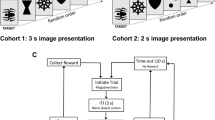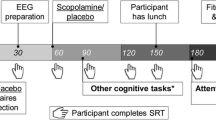Abstract
The effects of several centrally active drugs were investigated using two visual discrimination tasks: a two-lever food-rewarded conditional brightness discrimination, and a similar conditional brightness discrimination where a delay was introduced between the disappearance of the stimulus and the opportunity to respond on the levers for food. The substances tested (amphetamine, scopolamine, methylscopolamine, physostigmine, diazepam andβ-carboline benzodiazepine receptor antagonist, ZK 93426), all produced differing profiles of action on the performance parameters recorded. In the simple conditional visual discrimination, amphetamine increased omissions without significant effects on accuracy or response latency. Physostigmine enhanced response latencies and failures to respond without significant effects on accuracy. ZK 93426 had no consistent effects on accuracy although at higher doses, some increase in response latency was seen in the delayed responding version of the visual discrimination task. Diazepam had negative effects on all parameters in both discrimination procedures. Scopolamine disrupted responding, but not accuracy in the simple discrimination, whereas accuracy was reduced in a dose, but not delay dependent manner in the delayed discrimination. A similar effect to that observed with scopolamine was observed following methylscopolamine in the delayed discrimination procedure. In the simple visual discrimination small increases in accuracy were recorded, accompanied by increased response latencies.
Similar content being viewed by others
References
Andrews JS, and Holtzman SG (1988) Effects ofd-amphetamine, morphine, naloxone and drug combinations on visual discrimination in rats. Psychopharmacology 94:172–177
Bartus RT, Johnson HR (1976) Short-term memory in the rhesus monkey: disruption from the anticholinergic scopolamine. Pharmacol Biochem Behav 5:39–46
Becker RE, Giacobini E (1988) Mechanisms of cholinesterase inhibition in senile dementia of the alzheimer type: clinical, pharmacological, and therapeutic aspects. Drug Dev Res 12:163–195
Borbely AA, Schläpfer B, Trachsel L (1988) Effect of midazolam on memory. Arzneimittelforschung 38:824–827
Bushnell PJ (1990) Modelling working and reference memory in rats: effects of scopolamine on delayed matching-to-position. Behav Pharmacol 1:419–427
Cole SO (1982) Effects of chlordiazepoxide on discrimination performance. Psychopharmacology 76:92–93
Cole SO (1990) Diazepam-induced impairment of a go-no go successive discrimination. Behav Neurol Biol 53:371–377
Coyle JT, Price DL, Delong MR (1983) Alzheimer's disease: a disorder of cortical cholinergic innervation. Science 217:1184–1190
Dorow R, Horowski R, Paschelke G, Amin M, Braestrup C (1983) Severe anxiety induced by FG 7142, a β-carboline ligand for benzodiazepine receptors. Lancet 9:98–99
Dorow R, Berenberg D, Duka T, Sauerbrey N (1987) Amnestic effects of lormetazepam and their reversal by the benzodiazepine antagonist Ro 15-1788. Psychopharmacology 93:507–514
Duka T, Stephens DN, Krause W, Dorow R (1987) Human Studies on the benzodiazepine receptor antagonist β-carboline ZK 93426: preliminary observations on psychotropic activity. Psychopharmacology 93:421–427
Dunnett SB (1985) Comparative effects of cholinergic drugs and lesions of nucleus basalis or fimbria-fornix on delayed matching in rats. Psychopharmacology 87:357–363
Dunnett SB, Evenden JL, Iversen SD (1988) Delay-dependent short-term memory deficits in aged rats. Psychopharmacology 96:174–180
Dunnett SB, Rogers DC, Jones GH (1989) Effects of nucleus basalis magnocellularis lesions in rats on delayed matching and non-matching to position tasks. Eur J Neurosci 1:395–406
Evans HL (1975) Scopolamine effects on visual discrimination: modifications related to stimulus control. J Pharmacol Exp Ther 195:105–113
Flicker C, Serby M, Ferris SH (1990) Scopolamine effects on memory, language, visuospatial praxis and psychomotor speed. Psychopharmacology 100:243–250
Francis RL, Cooper SJ (1979) Chlordiazepoxide-induced disruption of discrimination behaviour: a signal detection analysis. Psychopharmacology 63:307–310
Hagan J, Morris RG (1989) The cholinergic hypothesis of memory: a review of animal experiments. In: Iversen LL, Iversen SL, Snyder SH (eds) Handbook of Psychopharmacology, vol 20: Psychopharmacology of the aging nervous system. Plenum Press, New York
Hearst E (1959) Effects of scopolamine on discriminated responding in the rat. J Pharmacol Exp Ther 126:349–358
Hodges H, Thrasher S, Gray JA (1989) Improved radial maze performance induced by the benzodiazepine antagonist ZK 93426 in lesioned and alcohol treated rats. Behav Pharmacol 1:45–55
Hughes RN, Blampied NM, Anderson GJ, Woollett GJ (1989) Methylscopolamine and conditioned location avoidance. Pharmacol Biochem Behav 33:913–914
Iwasaki T, Ezawa K, Iwahara S (1976) Differential effects of chlordiazepoxide on simultaneous and successive brightness discrimination learning in rats. Psychopharmacology 48:75–78
Jansen AAI, Gier de JJ, Slangen JL (1986) Diazepam-induced changes in signal detection performance. Neuropsychobiology 16:193–197
Kirk RC, White KG, McNaughton N (1988) Low dose scopolamine affects discriminability but not rate of forgetting in delayed conditional discrimination. Psychopharmacology 96:541–546
Koek W, Slangen JL (1983) Effects ofd-amphetamine and morphine on discrimination: signal detection analysis and assessment of response repetition in the performance deficits. Psychopharmacology 80:125–128
Ksir C (1975) Scopolamine and amphetamine effects on discrimination: interaction with stimulus control. Psychopharmacologia 43:37–41
Ksir C, Slifer B (1982) Drug effects on discrimination performance at two levels of stimulus control. Psychopharmacology 76:286–290
Milar KS (1981) Cholinergic drug effects on visual discriminations: a signal detection analysis. Psychopharmacology 74:383–388
Rupniak NMJ, Steventon MJ, Jennings CA, Iversen SD (1990) Comparison of four cholinomimetic agents on cognition in primates following disruption by scopolamine or by lists of objects. Psychopharmacology 99:189–195
Sahgal A, Keith AB, Lloyd S (1990) Opposing effects of vasopressin on matching versus non-matching to position: further evidence for response, not memory, modulation. Psychopharmacology 102:130–135
Sarter M, Steckler T (1989) Spontaneous exploration of a 6-arm radial tunnel maze by basal forebrain lesioned rats: effects of the benzodiazepine receptor antagonist α-carboline ZK 93426. Psychopharmacology 98:193–202
Spencer Jr DG, Emmett-Oglesby MW (1985) Parallel processing strategies in the application of microcomputers to the behavioral laboratory. Behav Res Methods Instr Comput 17:294–300
Spencer Jr DG, Pontecorvo MJ, Heise GA (1985) Central cholinergic involvement in working memory: effects of scopolamine on continuous non-matching and discrimination performance in the rat. Behav Neurosci 99:1049–1065
Stephens DN, Duka T, Andrews JS (1991) Benzodiazepines, α-carbolines and memory. In: Weinman J, Hunter J (eds) Memory: neurochemical and abnormal perspectives. Harwood Academic Publishers, London
Tan S, Kirk RC, Abraham WC, McNaughton N (1989) Effects of the NMDA antagonists CPP and MK-801 on delayed conditional discrimination. Psychopharmacology 98:556–560
Tan S, Kirk RC, Abraham WC, McNaughton N (1990) Chlordiazepoxide reduces discriminability but not rate of forgetting in delayed conditional discrimination. Psychopharmacology 101:550–554
van Haaren F, van Hest A (1989) The effects of scopolamine and methylscopolamine on visual and auditory discriminations in male and female Wistar rats. Pharmacol Biochem Behav 32:707–710
van Haaren F, van Hest A, van Hattum T (1989) Scopolamine and methylscopolamine differentially affect fixed-consecutive-number performance of male and female Wistar rats. Pharmacol Biochem Behav 33:361–365
van Hest A, van Haaren F, van de Poll NE (1990) Visual and auditory delayed discriminations in male and female Wistar rats. Behav Brain Res 37:29–36
Viscardi AP, Heise GA (1986) Effects of scopolamine on components of delayed response performance in the rat. Pharmacol Biochem Behav 25:633–639
Warburton DM, Brown K (1971) Attentuation of stimulus sensitivity induced by scopolamine. Nature 230:126–127
Warburton DN, Brown K (1972) The facilitation of discrimination performance by physostigmine sulphate. Psychopharmacologia 27:275–284
Author information
Authors and Affiliations
Rights and permissions
About this article
Cite this article
Andrews, J.S., Grützner, M. & Stephens, D.N. Effects of cholinergic and non-cholinergic drugs on visual discrimination and delayed visual discrimination performance in rats. Psychopharmacology 106, 523–530 (1992). https://doi.org/10.1007/BF02244825
Received:
Revised:
Issue Date:
DOI: https://doi.org/10.1007/BF02244825




